Squash vine borer moths have been caught in monitoring traps in New Hampshire, indicating that adults are likely to be flying and laying eggs in Maine soon. Similarly, early sightings of cabbage aphids have occurred in Massachusetts, so it’s best to start scouting for them if you’ve had problems with them before.
Cutworms have been a real nuisance on at least several farms this year, surprising even some experienced farmers. It’s good to remember that their damage is sometimes just leaf feeding, and not always the classic cut-through at the bottom of the stem.
Remember that clicking on an image will open a new browser tab with a larger copy of the same image.
Tortoise Beetle
Squash Bug
Cabbage Aphid
Squash Vine Borer
Cutworms
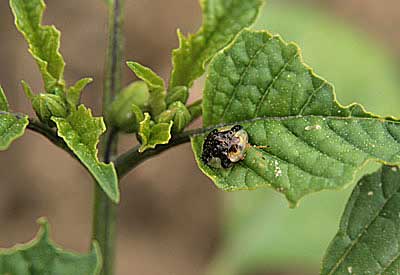 |
| Tortoise beetle |
TORTOISE BEETLE
These are relatively rare beetles, and typically only a minor pest, but I have received some emails asking about them. They do not typically cause serious damage and do not warrant spraying. The numbers are usually small and the beetles can be hand picked off.
They are oval to a square shape, clear to metallic looking with a dark square marking onthe center of their back. Once you see one you will remember it (see photo). There are a few species of tortoise beetles. The one I am getting the most calls about is feeding on eggplants, tomatillos, peppers and potatoes. They overwinter as adults and come out in the mid spring. They eat holes in the leaves.
There is a species known as the golden tortoise beetle which can be more of a pest, though they are beautiful to look at. They feed on sweet potatoes, and other species in the morning glory family, and can be a larger problem. When in small numbers, I recommend ignoring them or hand picking them off. If you have them, or other tortoise beetle species in large numbers, please let me know.
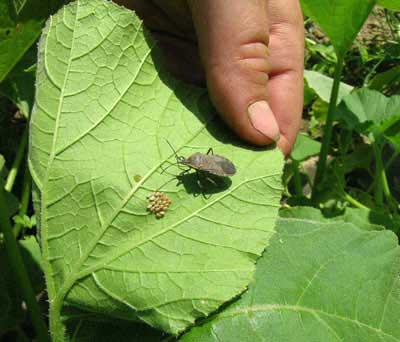 |
| Squash bug adult and eggs |
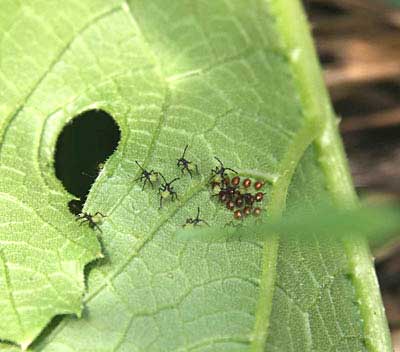 |
| Squash bug hatch |
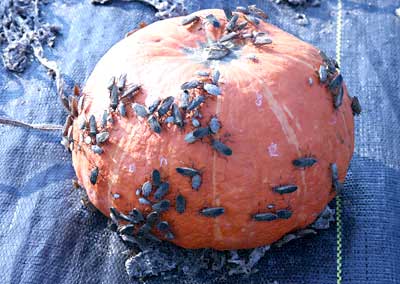 |
| Squash bug adults and older nymphs |
SQUASH BUG
By Eric Sideman
Squash bugs are serious pests of pumpkins and squash throughout North America. Plant damage, and bug survival, are low on watermelon, very low on cucumber and muskmelon, and highest on squash and pumpkin. Both adults and nymphs feed by inserting their beak and sucking juices from plant tissue. Toxic saliva injected during feeding causes foliage to wilt, then leaves turn black and die; the severity of this damage is directly related to density of squash bugs on each plant. Often I get calls from growers with squash bug problems who believe they have a disease. Later in the season, squash bugs may feed on the fruit, causing them to collapse or become unmarketable.
Adults are 0.5 to 0.75 of an inch long, flattened and grayish-brown. They hibernate in trash in and around the garden for the winter and emerge in the early summer to feed a bit and lay eggs. Eggs are laid in clusters usually on the underside of leaves and are orange when first laid, but turn bronze-colored before they hatch. The wingless nymphs are similar in appearance to adults, and are whitish when small, with a brown head, and grayish white when larger with black legs. There is one generation per year in the Northeast.
Black plastic, weed barrier fabric, straw mulch, and reduced tillage systems encourage higher populations, probably by providing good hiding places. Squash bug numbers are reduced by clean cultivation in the fall, and crop rotation. Infestation is delayed by row covers. If possible, rotate cucurbit crops between fields as far apart as possible. Keep headlands mowed and free of trash to reduce overwintering sites.
Squash bugs are unusually difficult to control with insecticides. Scout undersides of leaves for squash bug adults and eggs. Crush the eggs. You may not want to crush the bugs as they stink when you do.
If you miss some eggs and have to spray, try to time squash bug sprays to kill young nymphs just after hatch, because this stage is the easiest to control. Treat late in the day when the flowers are closed to reduce risk to bees. Neem products have proved effective.
For adult bug control, insecticides applied to the base of the plant are most effective, possibly because bugs tend to cluster. But, squash bugs are virtually impossible to control later in the season when nymphs are large and the canopy is dense.
(Source material from New England Vegetable Management Guide; Handbook of Vegetable Pests, A Capinera; ATTRA. And UMass Extension article by Andy Cavanagh & R Hazzard)
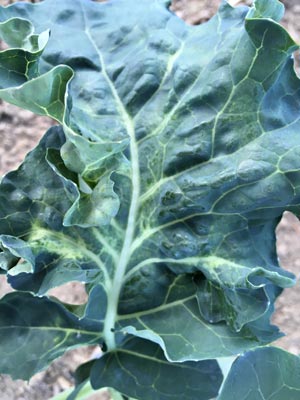 |
| Yellowing on a brassica leaf caused by cabbage aphids |
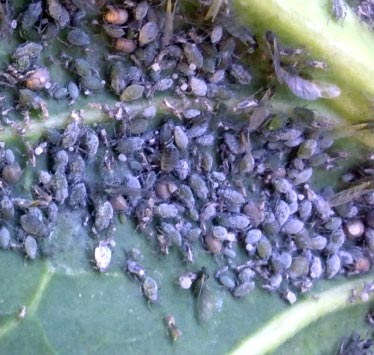 |
| Cabbage aphids – Brevicorynne brassicae |
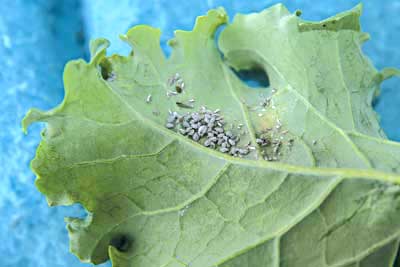 |
| Cabbage aphids on the underside of a leaf |
CABBAGE APHID
By Becky Sideman
Those who grow crops in the Brassica family are likely familiar with the cabbage aphid, Brevicoryne brassicae, sometimes referred to by growers as “gray aphid”. It is often a significant problem on fall brassica crops, especially Brussels sprout, kale, and broccoli. In recent years, many growers in northern New England have reported increasing crop losses caused by this pest, mostly on late fall brassicas. The earliest aphids are usually found in early summer.
Cabbage aphids have a distinctive whitish-gray appearance because they are covered with a white powdery wax coating. They are often found in thick clumps or colonies, feeding on the youngest tissue of Brussels sprouts, cabbage, broccoli, kale, and other members of the cabbage family.
Cabbage aphids overwinter as eggs laid on Brassica crops and weeds in the fall. The eggs hatch in early spring, giving rise to females that feed and produce live offspring. Winged aphids form after the initial infestations, and then fly to colonize new crops. In warmer climates, adults overwinter without producing eggs. It is possible that adults can overwinter in unheated high tunnels containing brassica crops here in the north. Some key cultural practices to manage cabbage aphid populations include destroying and burying brassica crop and weed residue in order to bury the eggs, managing brassica weeds (mustards, etc.), and rotating brassica crops away from where cabbage aphids were previously found.
Cabbage aphids are difficult to control if detected late in the season when populations are already very high. (It is also difficult to get insecticides to penetrate their thick colonies and into the crevices where they hide within the plant). Scout early and often, so that you know when they arrive. While the aphids themselves can be difficult to see, especially in small numbers, they produce a visible yellowing on the leaves. When you see this symptom as you walk the field, it is a good idea to examine plants more closely. Young broccoli showing characteristic yellowing where cabbage aphids have been feeding.
When there are only a couple of infested plants, you can rogue or remove those plants, or possibly even mechanically destroy the initial aphids. Because the winged aphids are distributed randomly, it is important to scout thoroughly on a weekly basis. Economic thresholds suggest that you should treat if at least 10% of the plants are infested. You can also follow this UC Davis sequential sampling procedure, to reduce time spent scouting. Colleagues at UMass created a helpful Brassica scouting sheet, which helps you record the presence of all major brassica pests in one place.
Recent research by the UMass Extension Vegetable Program and at the N.H. Agricultural Experiment Station have shown that decent control of cabbage aphid using organically approved insecticides is possible, but that it requires a regular scouting regime and repeated applications (we have used up to 7-8 applications per season), increasing in frequency later in the season as aphid populations climb. There are also many conventional options, but timely application and rotation between insecticide options is key. In all cases, getting good coverage and use of appropriate spreader stickers (following label recommendations) is critical.
For additional information about this pest, see the following useful resources:
University of California Pest Management Guidelines for Cabbage Aphid
Cabbage Aphid – within the New England Vegetable Management Guide
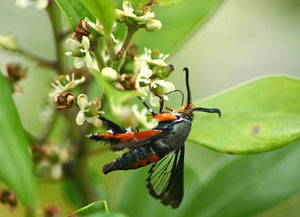 |
| Hawk moth – adult form of squash vine borer |
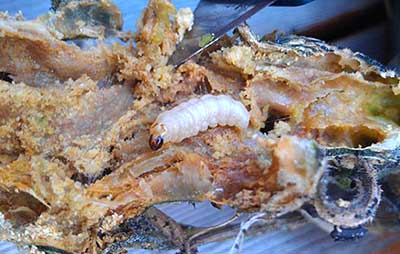 |
| Squash vine borer larva |
SQUASH VINE BORER
By Eric Sideman
Squash vine borer moths are day-flying moths with a 1.0 to 1.5 inch wingspan and bright orange markings. In flight, they look like wasps. There is one generation each year and adults emerge in late June/early July. The moths fly slowly in zig-zags around plants and lay eggs singly on stems; eggs are usually found on the main stem near the base, but are also found on leafstalks or on the undersides of leaves. Upon hatching, larvae bore into stems (where they are protected from insecticides). Thick-stemmed squashes are preferred. Unless you usetraps or scout fields for evidence of eggs or larvae, the first sign of squash vine borer infestation is often wilting vines in July and August. By that time, it is too late to do anything.
Growers should scout their pumpkin and squash fields weekly for squash vine borer from late June through early August. Examine the base of vines for eggs. The squash vine borer can be killed with an insecticide and the recommendation would be spinosad (for example, Entrust or Monterey Garden Spray), but appropriate timing is crucial. Bt also works, but Bt breaks down more quickly. Bt aizawai (for example Agree WG) has been
shown to work better than Bt kurstaki (for example Dipel). Either insecticide is only effective when applied for young larvae to eat before they bore into the stem. Once they are in the stem the insecticide will be useless. If you see the moths flying or find eggs,then two insecticide sprays, ideally applied to the base of the plants and timed five to seven days apart, will control newly hatching larvae before they are able to bore into the stem. Again, the timing is crucial and there is no point in spraying before you find evidence, or after the larvae boreinto the stem.
If evidence of larval feeding (sawdust-like frass near entrance holes) is found, then split open the stem to confirm the presence of larvae, which, by the way, may suggest more eggs are being laid so scout. Borers can be removed from vines if detected before much damage is done. Slit the stem longitudinally, remove the borer, then cover the wounded stem with moist soil above the point of injury to promote additional root formation.
Some growers monitor for the moths using Scentry Heliothis pheromone traps from early June through early August. If more than 5 moths per week are captured, then they make 2 to 4 weekly applications of pesticides. Timing is very important, so this is not recommended for the casual gardener.
(Source material from New England Vegetable Management Guide; Handbook of Vegetable Pests, A Capinera; ATTRA, UMass Vegetable Newsletter and URI Extension Fact Sheet)
 |
| Cutworms around a broccoli seedling |
CUTWORMS (many species)
By Eric Sideman
Cutworms are occasional pests of many crops early in the season, including carrots, peas, onions, spinach, broccoli and the list goes on and on. Some years they result in major losses, other years result in no loss at all. They are larvae of a dozen or so different species of night flying moths. They are greasy looking caterpillars that have a habit of curling into a “C” shape when disturbed. Many species that attack vegetables overwinter, as partially grown larvae, can become active very early in the spring when the plants first germinate and are very susceptible. Others arise from moths that fly early in the spring, and these feed well into the early summer. Cutworms hide in the soil during the day and crawl on the surface at night. They feed and cut off young seedlings at the soil surface, or climb up and chew on the leaves. During the day, you can dig around an inch or two deep around damaged plants and often find the ugly critter. Chickens love them.
Cultural Control
Since most species lay their eggs in the late summer/fall on vegetation, keeping fields clean of weeds and crops in the fall helps. Of course, this goes counter to the recommendations to keep the soil covered cropped, so it is a management decision based on how bad the problem has been. Fall plowing exposes larvae to birds. Cultivating fields in the spring just after vegetation has appeared and grown a few inches, and keeping it clean cultivated can starve the cutworms out before the peas go in. But in most areas this is not practical because crops need to be planted.
On a small scale, collars built around each plant will keep the caterpillar away. Going out at night with a flash light and hand picking breakfast for your chickens can work.
Materials Approved for Organic Production
Entomopathogenic nematodes show good efficacy when environmental conditions are favorable. Steinernema carpocapsae has been shown to be very effective against cutworms. Success with nematodes depends on proper application methods. Be sure to follow the instructions from the supplier carefully. A few suppliers of these insect-attacking nematodes are IPM Laboratories (www.ipmlabs.com), and ARBICO (www.arbico.com).
Baits – Spinosad or Bt will kill the caterpillars, but getting the pest to consume the insecticide as a sprayed on material before significant damage is done is not likely. However, farmers and gardeners have reported good results using these materials in baits. The bait is spread on the ground near the plants, or prior to planting to clean out an area.
Spinosad – Seduce (OMRI Listed) is a commercial bait.
Bt – A bait made from Bt is often recommended and has received good reports from farmers. This is a method of use for Bt that is not described on the label. This off-label use is permitted by EPA under FIFRA 2ee, but growers should check with their state pesticide regulators about their state regulations. Make the bait by mixing the highest concentration solution of Bt allowed on the label and then mixing in a bit of molasses and alfalfa meal or bran. Then dampen this mix if necessary. Spread the bait along the planted or planned rows in the evening.

